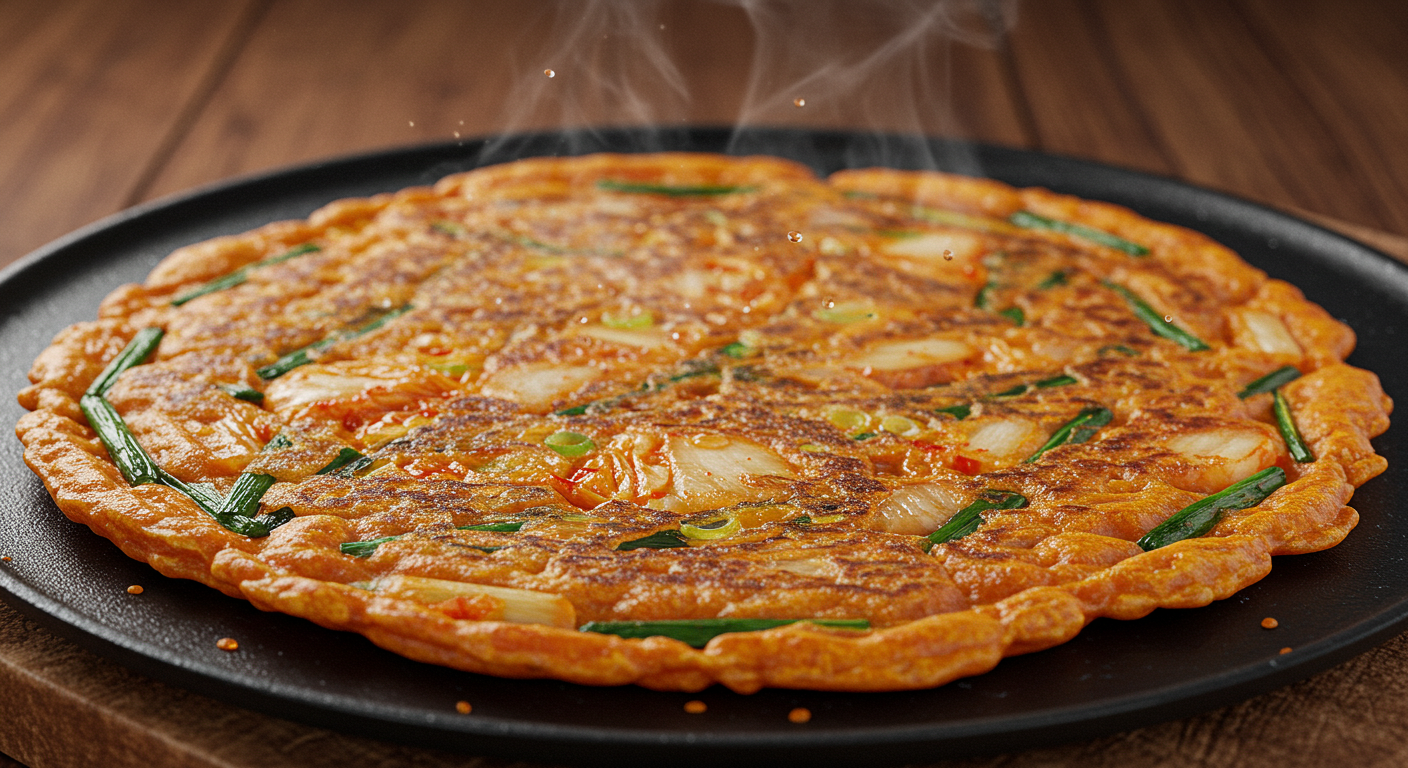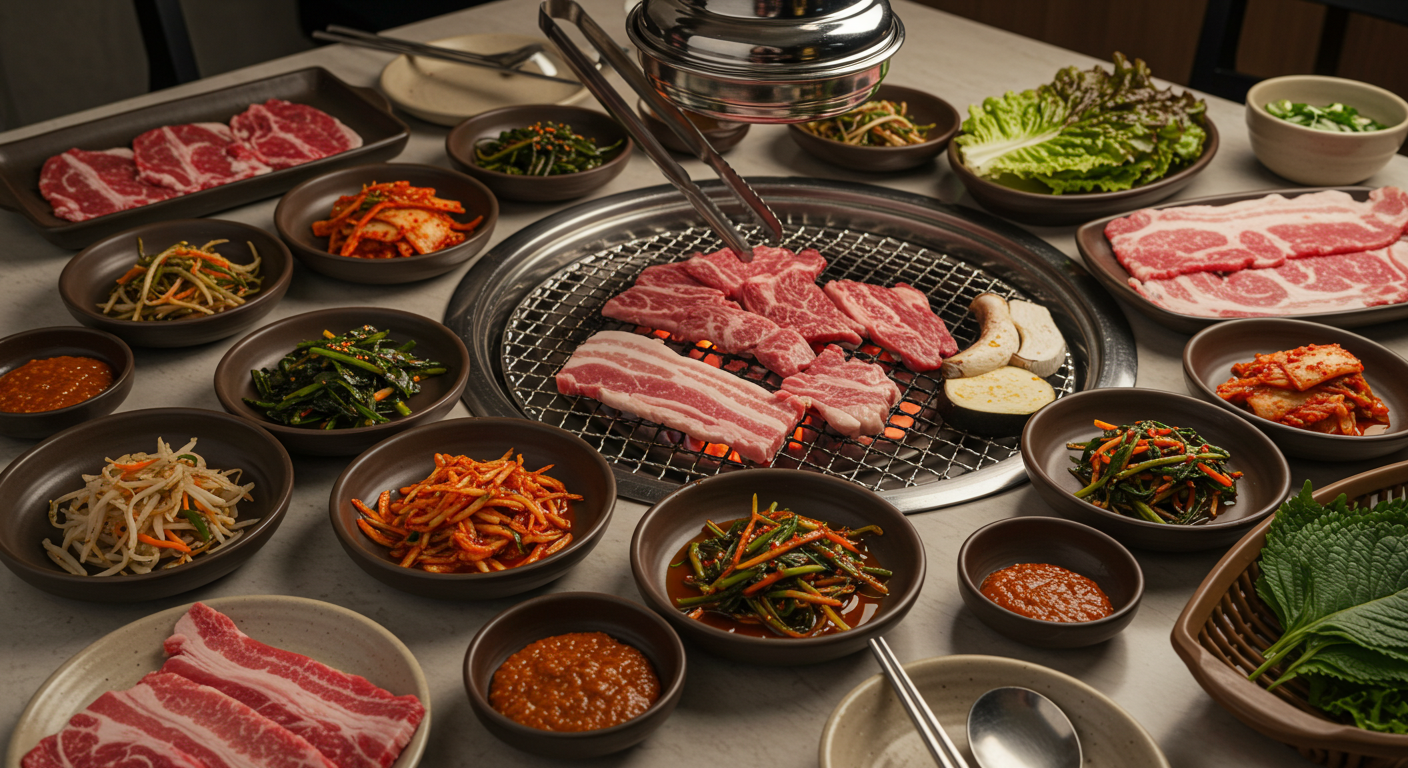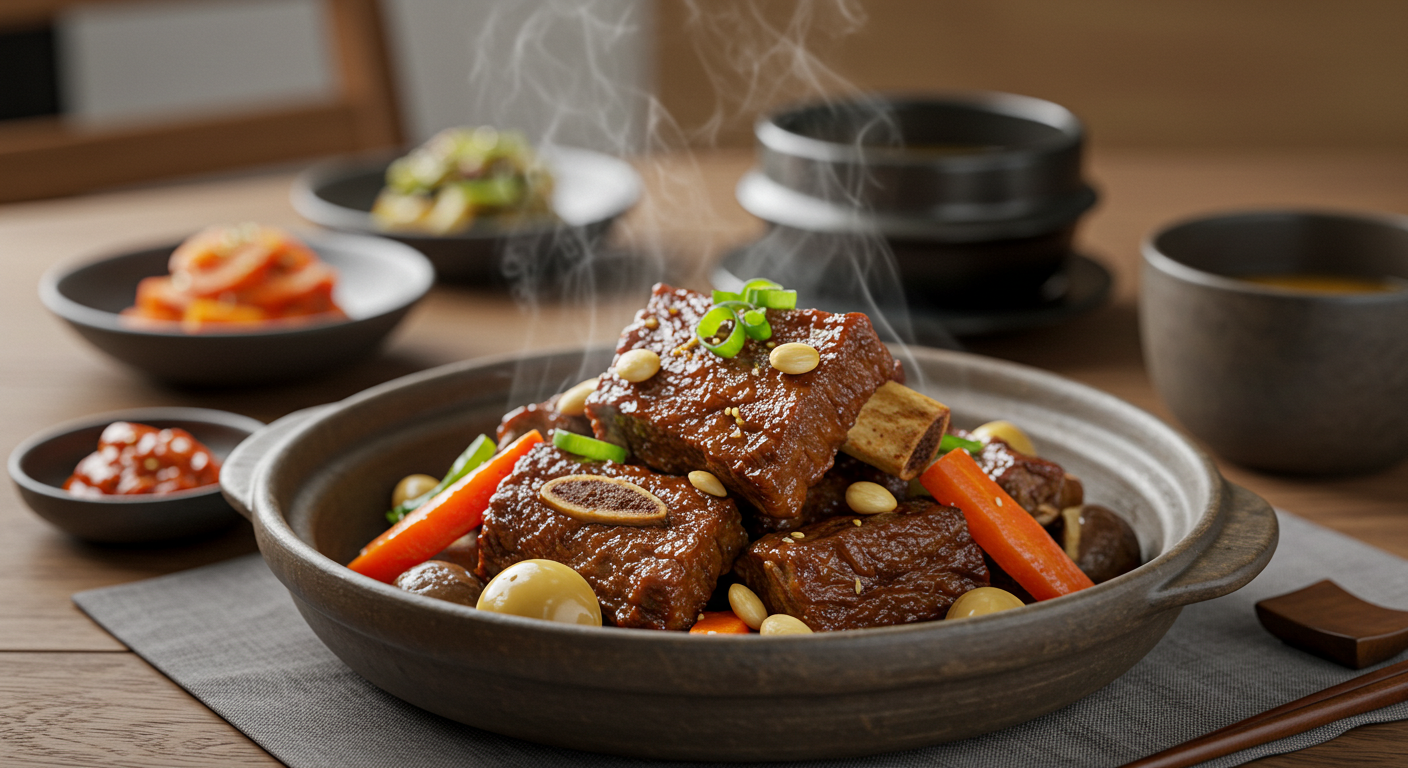
Korea’s Soul Food, Gimbap! Are you looking for an easy and delicious way to make Gimbap at home? This guide will help anyone make wonderful Gimbap!
Hello, everyone! Do you like Korean food? Honestly, I don’t think there’s any food as perfect as Gimbap. Whether it’s for a picnic, a quick meal, or just when you suddenly crave something delicious! Gimbap is always the best. 😊
But have you ever thought about making it yourself? You might worry, “Isn’t it too difficult?” or “Aren’t there too many ingredients?” I felt the same way when I first tried to make Gimbap! But don’t worry. Today, I’m going to show you how to make Gimbap in a very detailed and friendly way, so even foreign friends can easily follow along. Let’s become Gimbap masters together! 🍙
What is Gimbap? 🤔
Gimbap is one of Korea’s representative dishes, made by rolling ‘rice’ and various ‘ingredients’ in ‘seaweed’. You might think it’s similar to Japanese makizushi, but Gimbap uses rice seasoned with sesame oil and salt instead of vinegared rice, and it’s filled with various vegetables, meat, and eggs instead of raw fish. So, even those who don’t eat raw food can enjoy it without any hesitation!
In Korea, it’s the most popular menu item for picnics and is easily found in snack bars, making it a national snack. There are so many kinds, from basic Gimbap to Tuna Gimbap, Cheese Gimbap, Pork Cutlet Gimbap, and countless others. Isn’t the biggest charm of Gimbap that you can change the ingredients as you like? 😊
Essential Ingredients! 🥦🥕🥚
To make Gimbap, you first need to prepare the ingredients, right? Don’t be intimidated by the number of items! I’ll tell you about the essentials. Most of these ingredients can be easily found at Asian markets or large supermarkets.
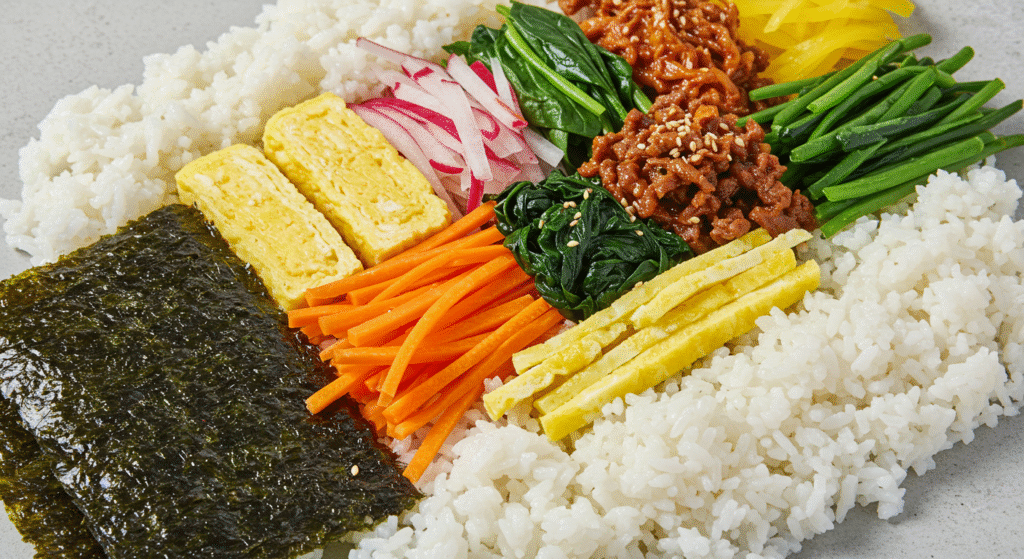
Basic Gimbap Ingredients List
| Category | Ingredient | Description (Substitutions) |
|---|---|---|
| Rice | 2 cups warm rice (approx. 400g) | Freshly cooked rice is best! |
| Seaweed | 4-5 sheets Gimbap seaweed | Thicker and larger than regular seaweed. |
| Pickled Radish | Gimbap pickled radish (danmuji) | Essential sweet and sour flavor for Gimbap! |
| Fish Cake | 4-5 imitation crab sticks (mat-sal) | Also known as crab sticks. (Optional) |
| Ham | Gimbap ham or regular ham | Slice into long strips. |
| Eggs | 3-4 eggs | Make an omelet and slice it thinly. |
| Spinach | A handful of spinach (approx. 150g) | Can be substituted with other green vegetables. (e.g., cucumber, zucchini) |
| Carrot | 1/2 carrot | Adds color and texture. |
| Optional Ingredients | Braised burdock, stir-fried fish cake, tuna, cheese, etc. | Add according to your preference! |
Rice Seasoning Ingredients
- 1 Tablespoon sesame oil
- 1/2 Teaspoon salt
- 1 Tablespoon sesame seeds
💡 Good to know!
There are no fixed ingredients for Gimbap! You can add your favorite vegetables or meats, or omit ingredients you don’t like. Try making your own Gimbap with ingredients you have in your fridge!
Ingredient Preparation & Cooking Method 🍳
Now, shall we prepare the Gimbap fillings one by one? It’s simpler than you think!
- Seasoning the Rice: In warm rice, add 1 tablespoon of sesame oil, 1/2 teaspoon of salt, and 1 tablespoon of sesame seeds. Gently mix with a spatula, being careful not to mash the rice grains!
- Blanching Spinach: Wash spinach thoroughly, blanch in boiling water with a pinch of salt for about 30 seconds, then rinse in cold water and squeeze out excess water. Season with sesame oil and salt.
- Stir-frying Carrots: Julienne carrots, lightly oil a pan, add a pinch of salt, and stir-fry until soft.
- Making Egg Omelet: Beat eggs, season lightly with salt, cook a thin omelet in a pan, and slice into long strips.
- Stir-frying Ham & Imitation Crab: Slice ham and imitation crab into long strips and lightly stir-fry in a pan. (Optional)
- Preparing Pickled Radish & Burdock: Lightly drain or prepare Gimbap pickled radish and burdock as is.
⚠️ Be careful!
All ingredients should be drained as much as possible to prevent Gimbap from spoiling easily and to enhance the flavor. Especially squeeze out the water from spinach and pickled radish!
Rolling Gimbap: Almost there! 🎬
The highlight of Gimbap making! The rolling process. It might be a bit tricky at first, but you’ll get used to it quickly. Referring to a YouTube video will be very helpful!
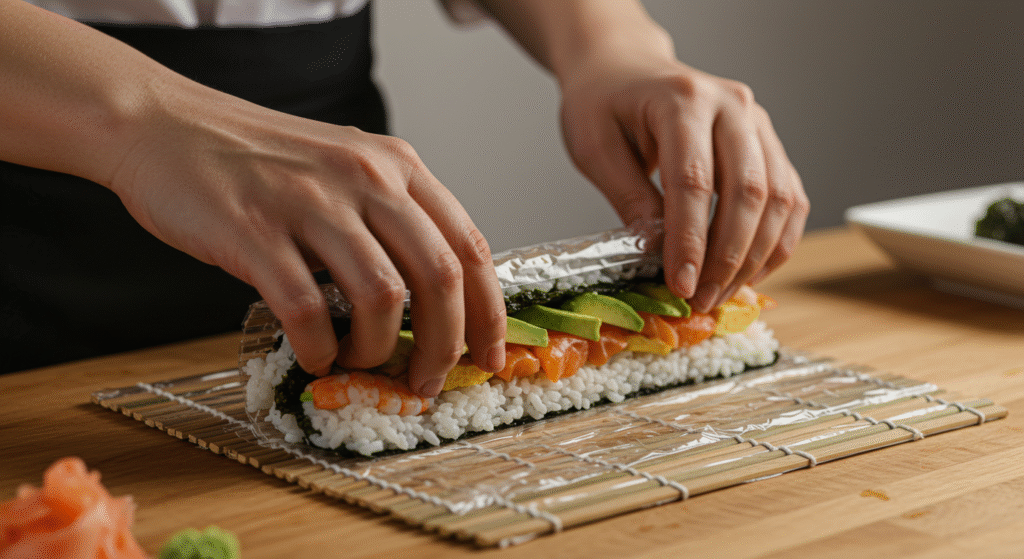
Step-by-step Gimbap Rolling Guide
- Lay out the Seaweed: Place the seaweed sheet on a bamboo rolling mat with the rough side facing up. (If you don’t have a bamboo mat, you can use plastic wrap or foil!)
- Spread the Rice: Spread the seasoned rice thinly over about 2/3 of the seaweed. Leave 1-2 cm empty at the far end of the seaweed (the part you’ll roll up). If the rice sticks to your hands, lightly apply sesame oil or wet your hands with water.
- Add Ingredients: Neatly place the prepared ingredients on top of the rice, arranging them by color. Don’t add too much, or it might burst!
- Roll Tightly: Use the bamboo mat to firmly hold the ingredients, lift the mat, and roll the Gimbap forward tightly. Press the mat gently as you roll to make the Gimbap firmer.
- Seal the End: Once fully rolled, apply a little water to the end of the seaweed to help it stick.
- Slice: Lightly brush sesame oil on the surface of the finished Gimbap. Dip your knife in sesame oil and slice the Gimbap into bite-sized pieces. Oiling the knife helps the Gimbap cut cleanly!
Gimbap Rolling YouTube Video Reference 🎬
It’s a bit hard to explain just with words, right? Watching the YouTube video below will help you understand much more easily. Try following along while watching!
Tips for Enjoying Deliciously! 😋
Finally, Gimbap is done! It’s delicious on its own, but here are a few tips to enjoy it even more.
- Eat Immediately: Gimbap tastes best right after it’s made! I recommend eating it before the seaweed gets soggy.
- With Various Sauces: It’s also a treat to eat with your favorite sauces like soy sauce, wasabi, gochujang (Korean chili paste), or mayonnaise. Personally, I love dipping it in spicy Tteokbokki (spicy rice cake) sauce the most! 🤤
- Using Leftover Gimbap: If you have leftover Gimbap, dip it in egg wash and pan-fry it to make ‘Gimbap-jeon’ (Gimbap pancake), which is also incredibly delicious!
- Make Your Own Gimbap: Add your favorite ingredients like tuna mayo, bulgogi, cheese, or fried items to create your unique Gimbap in the world.
📌 Important!
Gimbap rice can harden when stored in the refrigerator. It’s best to eat it as soon as possible, and if you have leftovers, pan-frying them with egg is the best way to enjoy them!
Conclusion: The Joy of Making Gimbap 📝
What do you think? Making Gimbap isn’t as hard as it seems, is it? Preparing the ingredients might take a little effort, but it will be a truly enjoyable time if you make it with family or friends. I personally feel happiest when I make Gimbap with my children. Even their squabbles over who gets to add their favorite ingredients become precious memories. 🥰
When you take a bite of homemade Gimbap, you’ll truly be touched by the effort and taste. I hope this article has been helpful for your first Gimbap-making experience! If you have any questions while making it, or if you have your own special Gimbap recipe, please let me know in the comments! 😊
💡
Gimbap Making Key Summary
✨ Gimbap is Freedom! Make your own Gimbap with your favorite ingredients. (Vegetables, meat, eggs, etc.)
📊 Ingredient Prep: Season rice, stir-fry vegetables, make egg omelet, etc., prepare each ingredient in advance.
🧮 Rolling Gimbap:
Place seaweed-rice-ingredients on a bamboo mat in order and roll tightly.
👩💻 Enjoy Deliciously: Best eaten right after making! Pairs well with various sauces.
Making Gimbap is easier than you think, and even more fun when done together!
Frequently Asked Questions ❓
Q: Is Gimbap seaweed (gim) essential?
A: 👉 Yes, it’s thicker and larger than regular seaweed, making it much easier to roll Gimbap. We recommend using Gimbap seaweed!
Q: Does the rice have to be warm?
A: 👉 Yes, warm rice mixes better with seasoning and sticks well to the seaweed. Be careful not to use rice that’s too hot to avoid burning your hands.
Q: My Gimbap keeps breaking. What should I do?
A: 👉 This could happen if you put too many ingredients or didn’t press firmly enough when rolling. Adjust the amount of ingredients and try pressing firmly with the bamboo mat as you roll!
Q: Can I make Gimbap in advance?
A: 👉 Gimbap tastes best right after it’s made. The rice can harden and the seaweed can get soggy over time, so it’s best to make it just before eating.
Q: Can I make vegetarian Gimbap?
A: 👉 Of course! You can make delicious vegetarian Gimbap by replacing ham and imitation crab with tofu, mushrooms, or avocado. Ingredients can be freely changed!

